This Mulled Wine Cake is ALL the holiday cheer and flavor trapped in a slice of cake! A delightfully light and delicious vanilla sponge cake brushed with mulled wine syrup, filled with fruits, and frosted with a fantastic wine flavored whipped cream frosting.
This showstopping mulled wine cake is a guaranteed crowd-favorite! A light, fresh, and delicious cake is the perfect ending to any celebratory dinner.
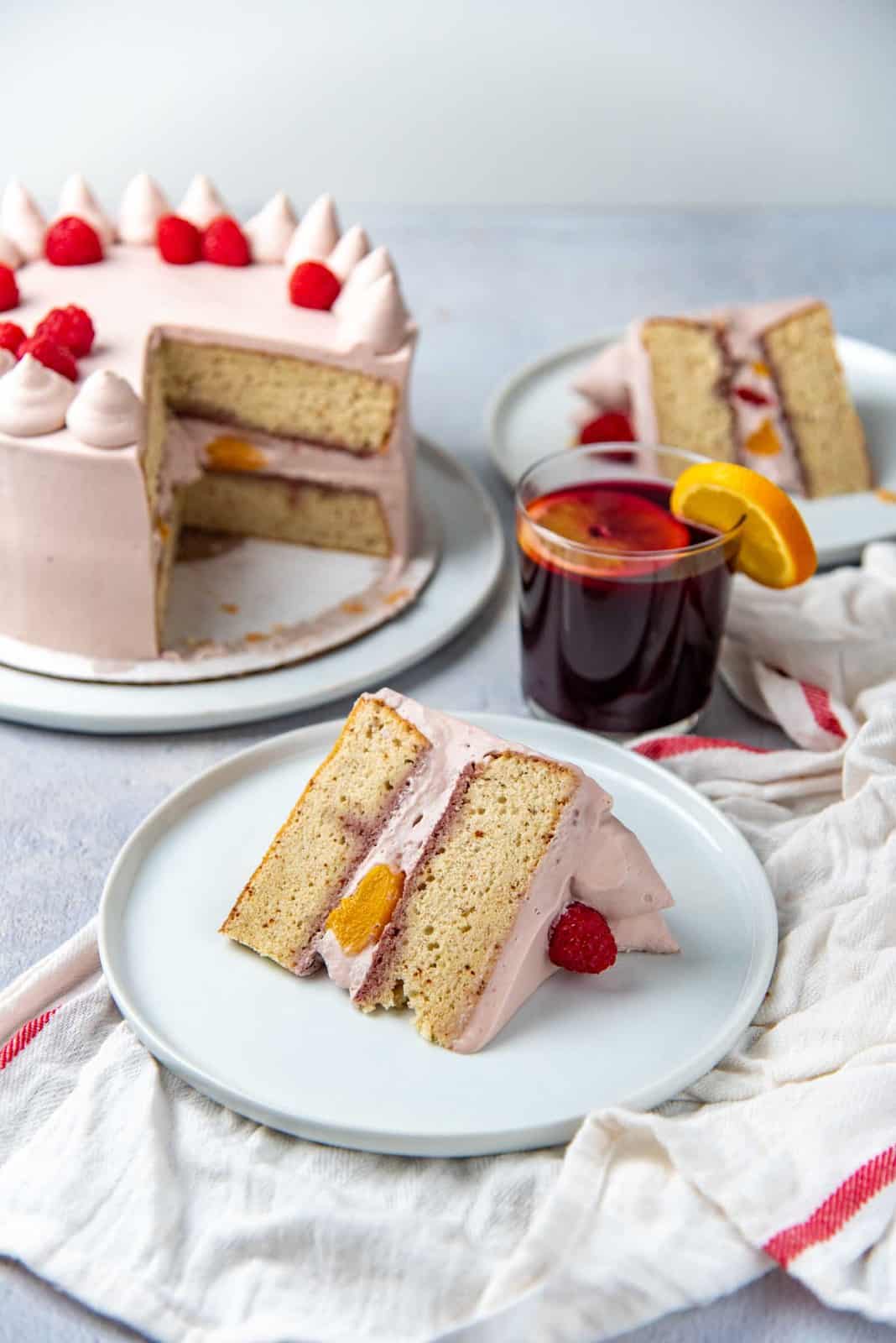
This mulled wine cake packs quite a flavor-punch and it’s one of my favorite cake recipes. If you’re looking for a cake that is not too rich, but packed with flavor, then you just can’t go wrong with this cake!
It’s light and fruity, so it’s perfect as a summer cake, but also doubles up as a winter/holiday cake with the mulled wine flavors.
A light vanilla sponge cake brushed with mulled wine syrup, filled with berries and peaches, and then frosted with a whipped cream flavored with more mulled wine. It’s a party in your mouth!
Components of this mulled wine cake recipe
- Mulled wine syrup
- Vanilla genoise sponge cake
- Mulled wine flavored whipped cream frosting (chantilly cream)
- Fruit filling
Let’s check out each of these components briefly.
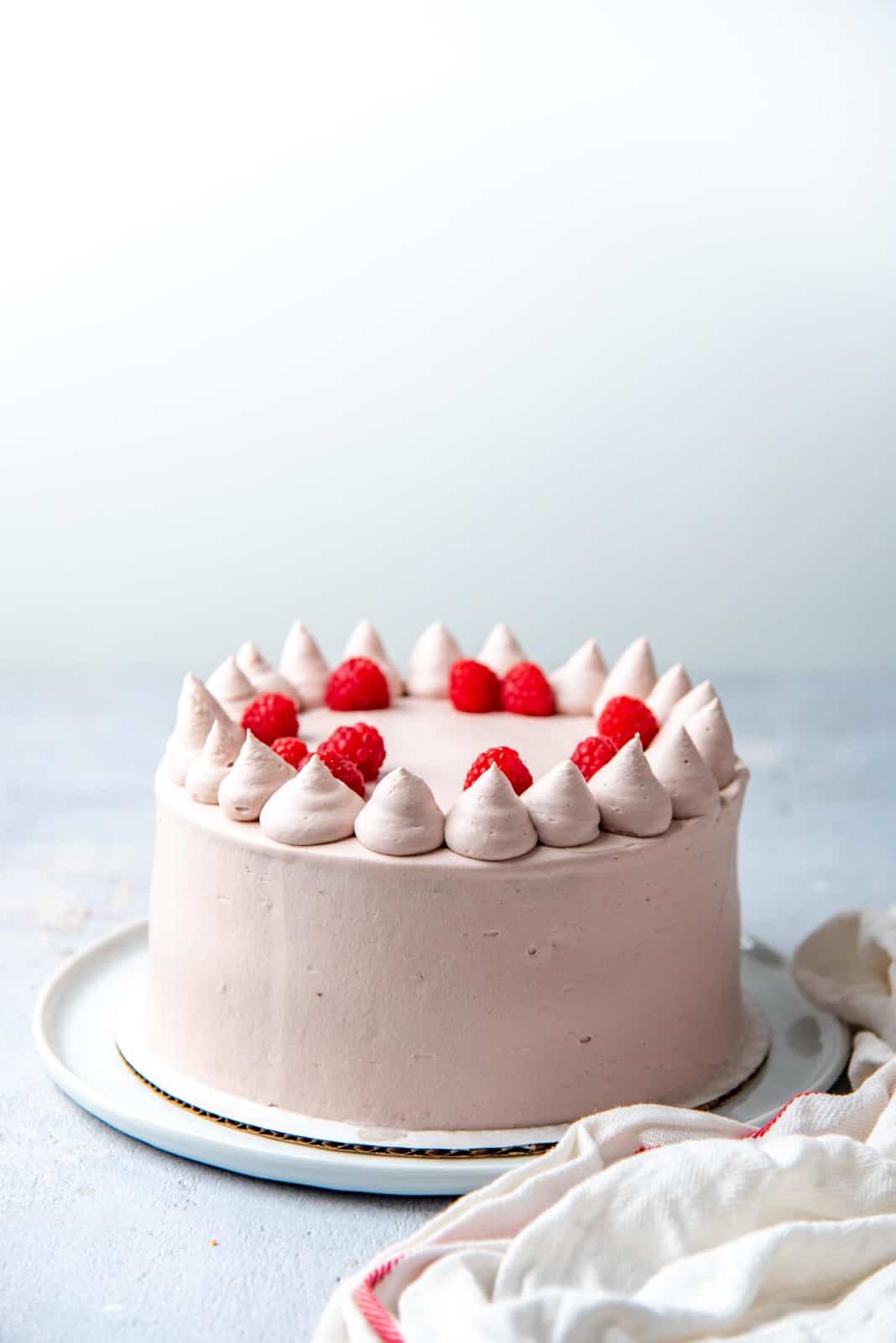
Mulled wine syrup
You will need,
- One bottle of red wine (any red wine you like to drink)
- White sugar
- Whole orange
- Cloves
- Star anise
- Cinnamon
Place all the ingredients in a saucepan. Bring it to a simmer and let everything infuse for about 30 minutes.
Then remove all the spices and fruits, and reserve about 3/4 – 1 cup of the mulled wine, and reduce the rest of the mulled wine to about 1/2 – 3/4 of a cup. Let it cool and set aside until needed.
You can make this the day before, and leave both the mulled wine and the reduced syrup in the fridge until needed.
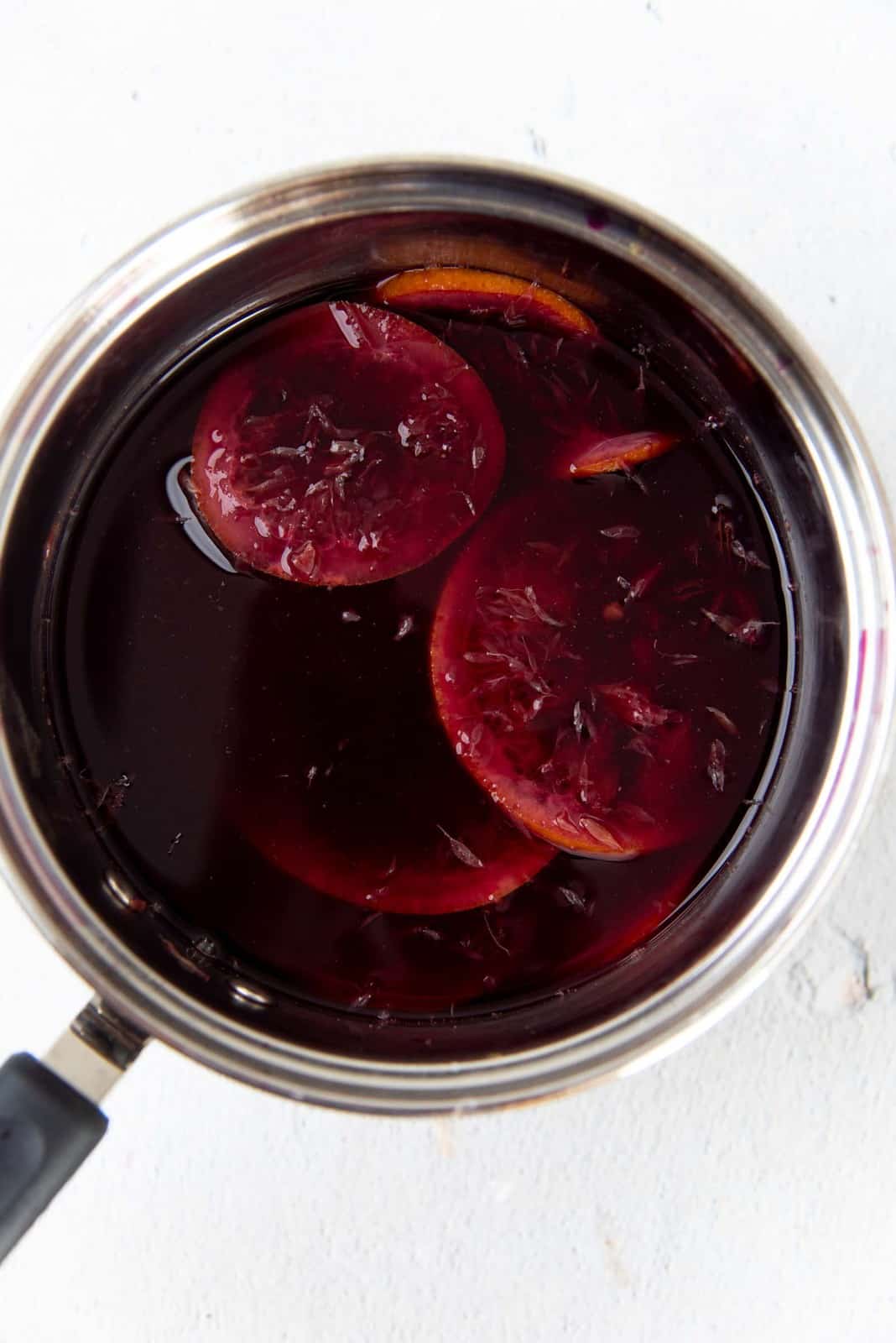
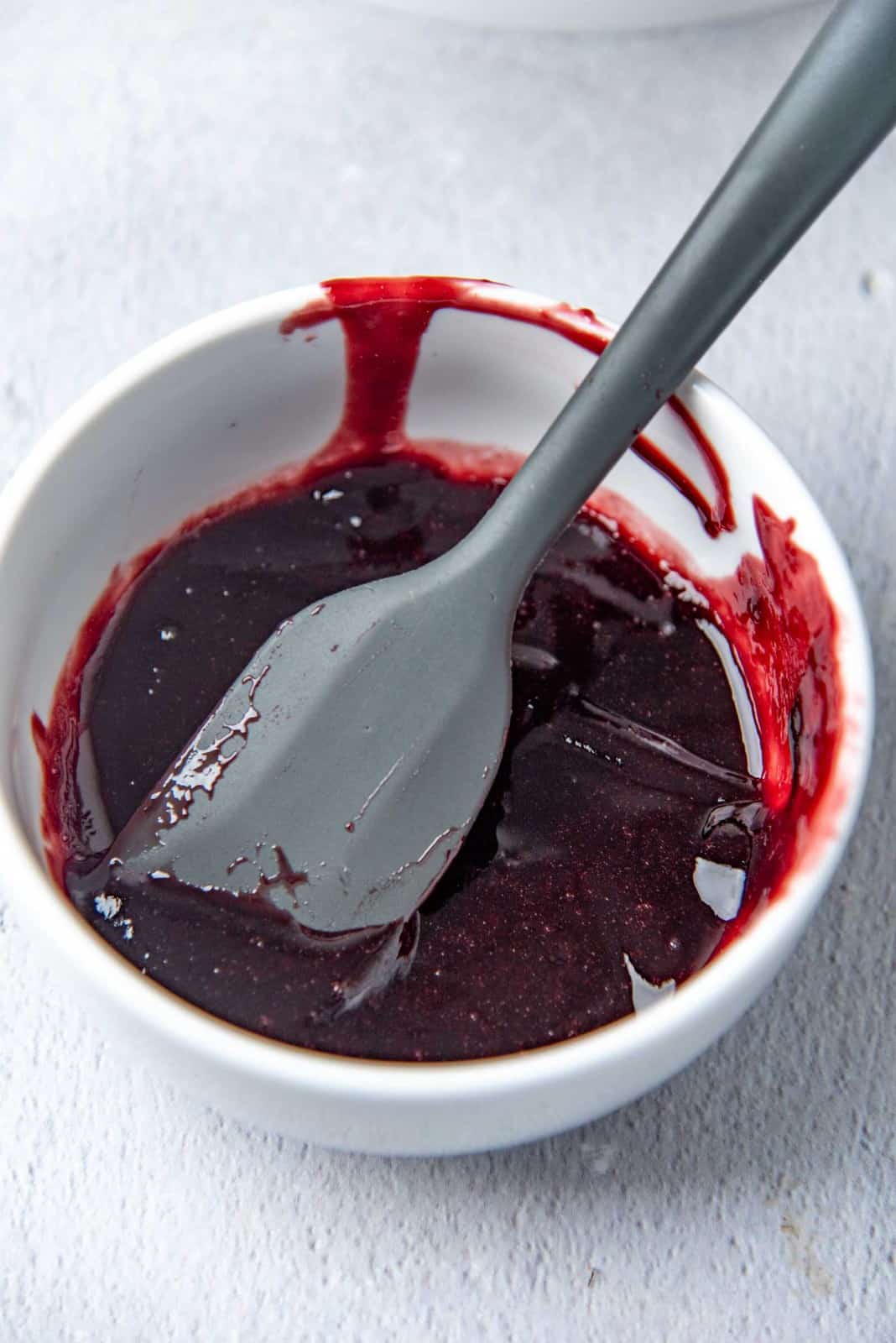
Vanilla genoise sponge cake
How to prepare the cake pan for the cake
It’s very important that the cake does NOT stick to the pan, and there is just the minimum amount of butter on the sides of the pan as well.
I prefer to line the whole cake pan with parchment paper. I use a little butter to stick the parchment paper to the pan, and then I make sure there is no butter ON the parchment paper itself.
How to make the sponge cake batter
This mulled wine cake is made with genoise sponge cake. Genoise sponge cakes are made by whipping whole eggs into a foam. Then you gently fold in the dry ingredients, along with melted butter for added flavor. I didn’t add wine flavor into the cake here, because I prefer the contrast between the syrup flavor, whipped cream, and the vanilla flavor of the cake.
You will need,
- Large eggs
- Cake flour (AP flour can also work)
- Baking powder
- Vanilla extract
- Melted butter or brown butter for even more flavor
To make the genoise sponge cake, it’s important to prep the eggs so that you can get the most volume. This is done by heating the eggs and sugar together over a bain-marie. The heating process breaks down the protein in the egg which allows for more air to be incorporated into the foam, and stabilizes the foam more as well.
When the egg and sugar mixture has been heated to 110 – 120 F, whip the egg mix until it’s about 3 times the initial volume. This can take about 6 – 8 minutes.
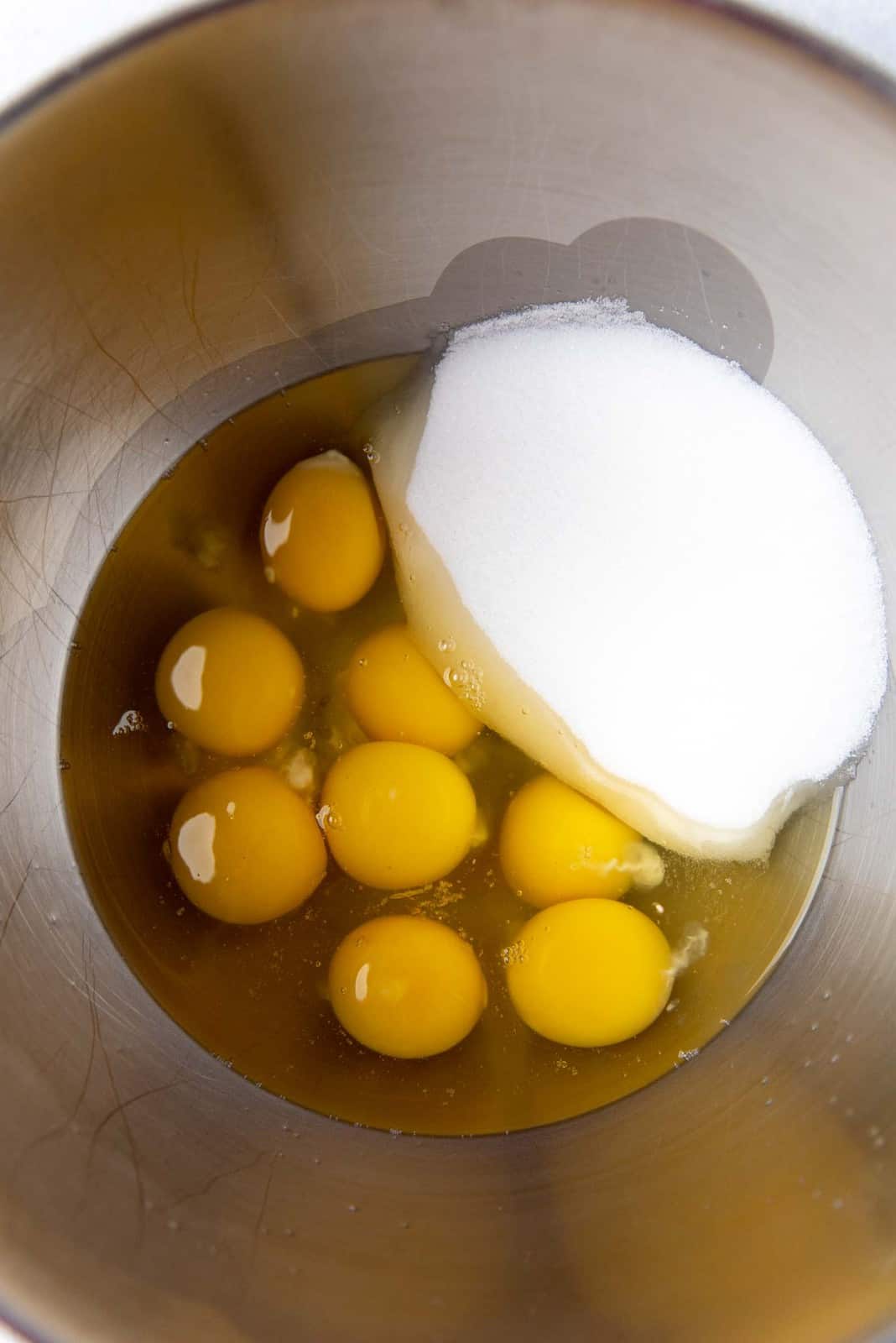
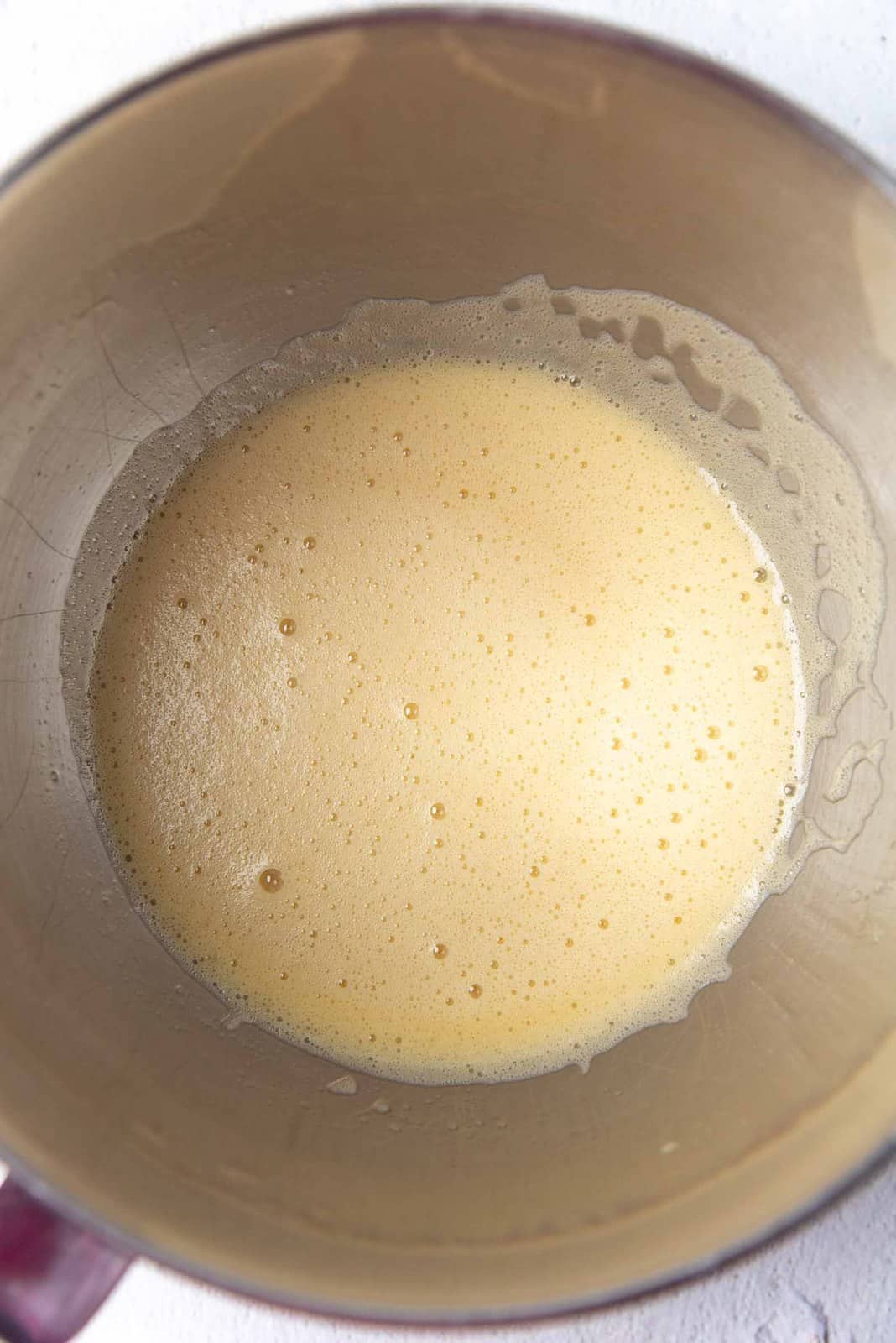
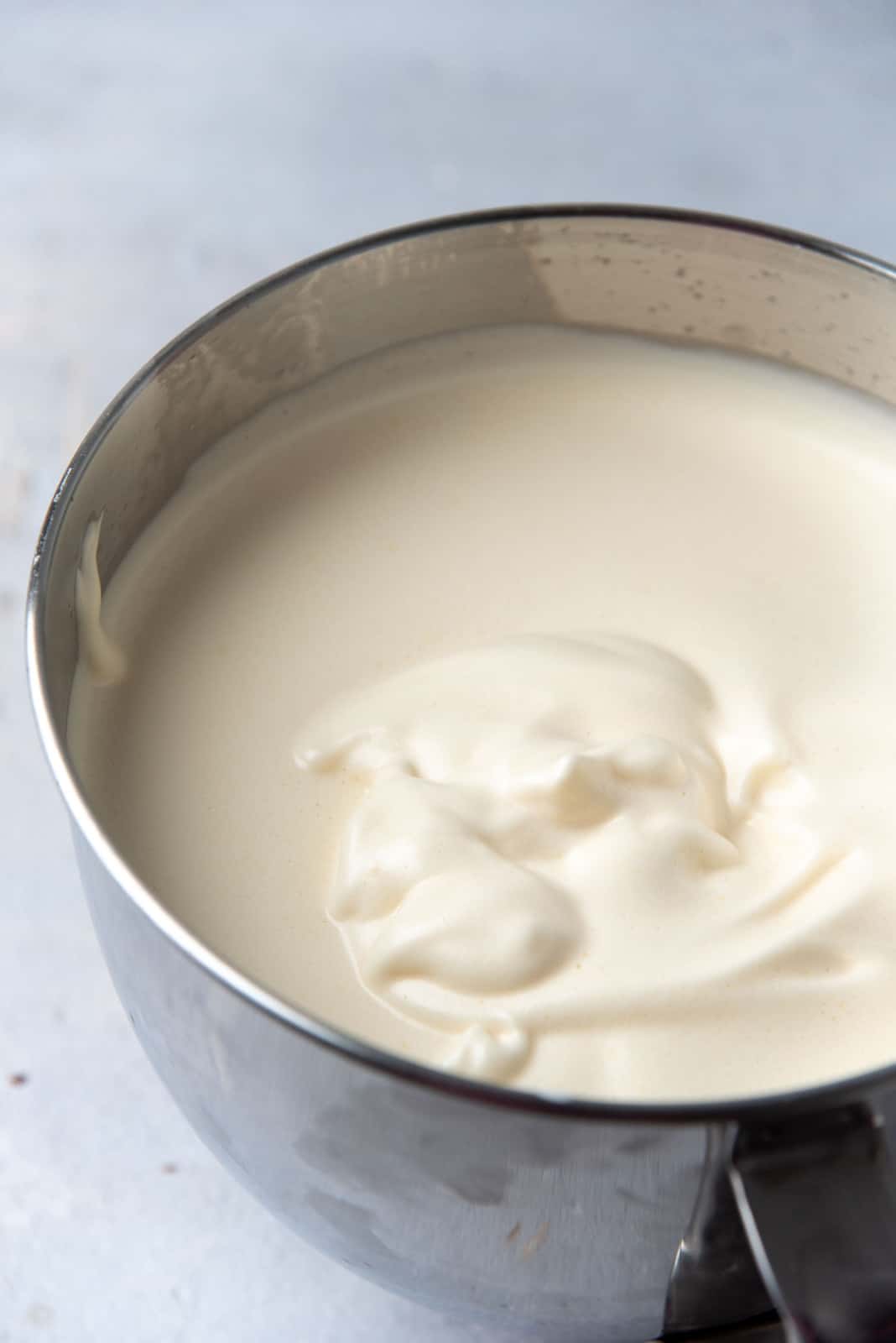
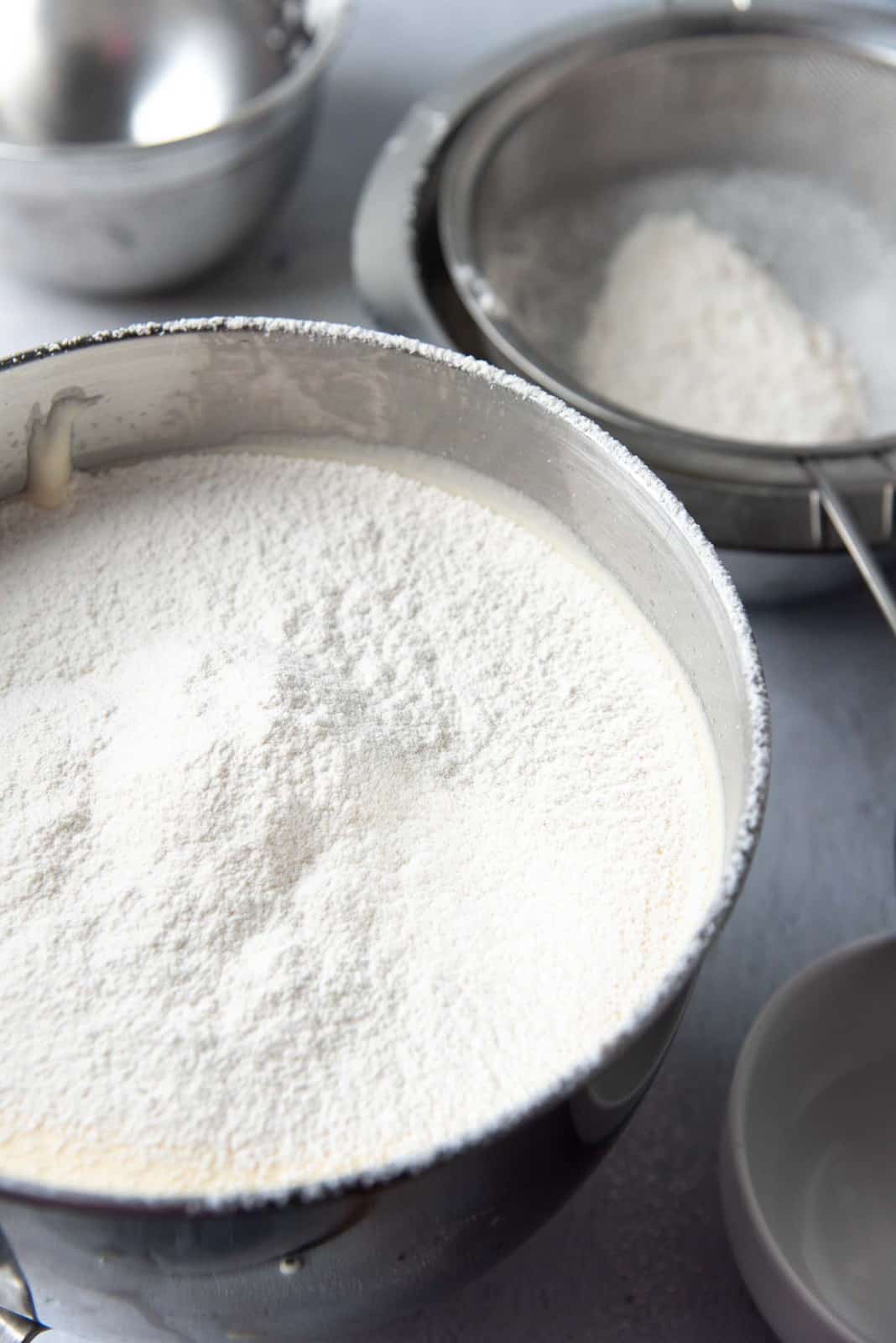
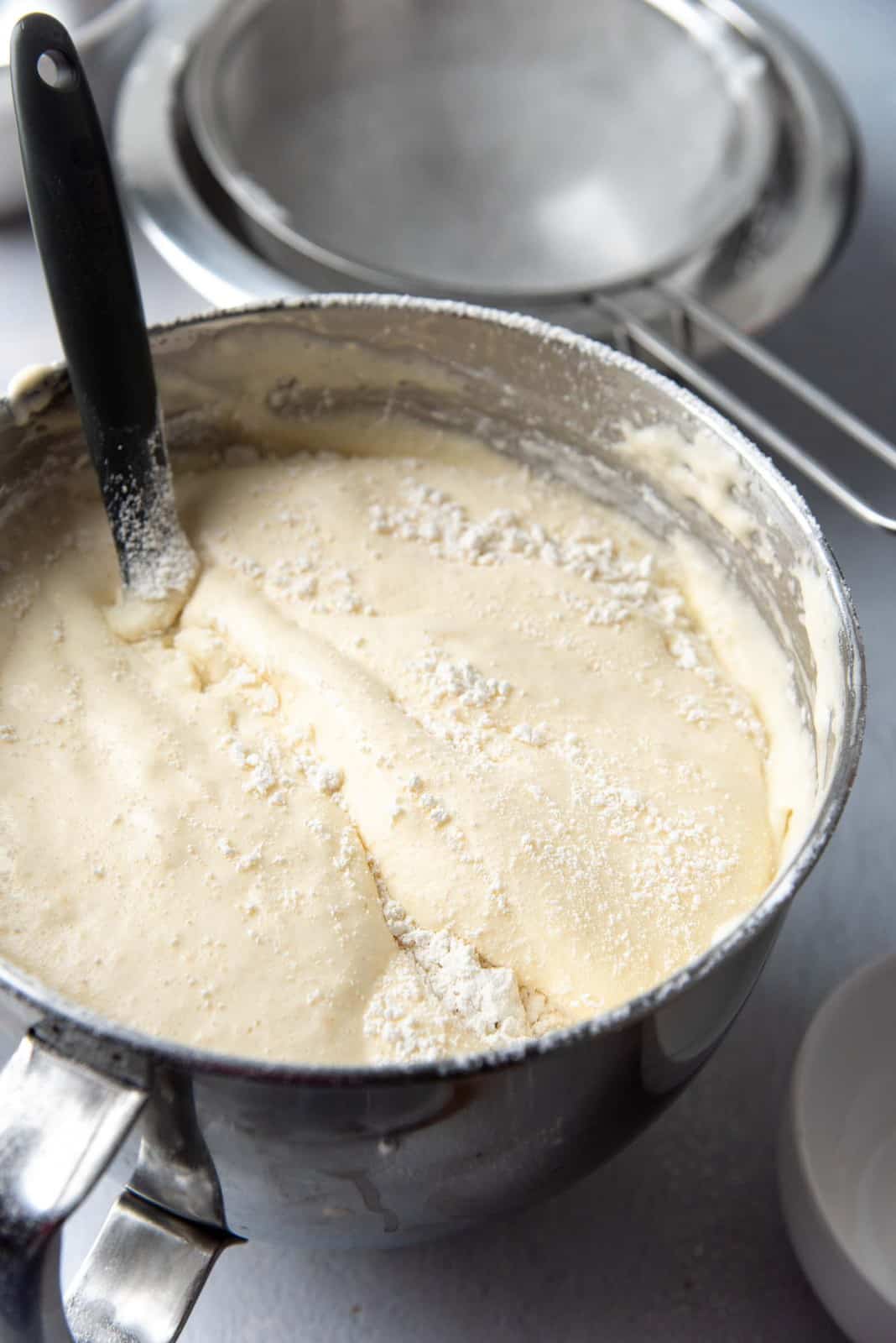
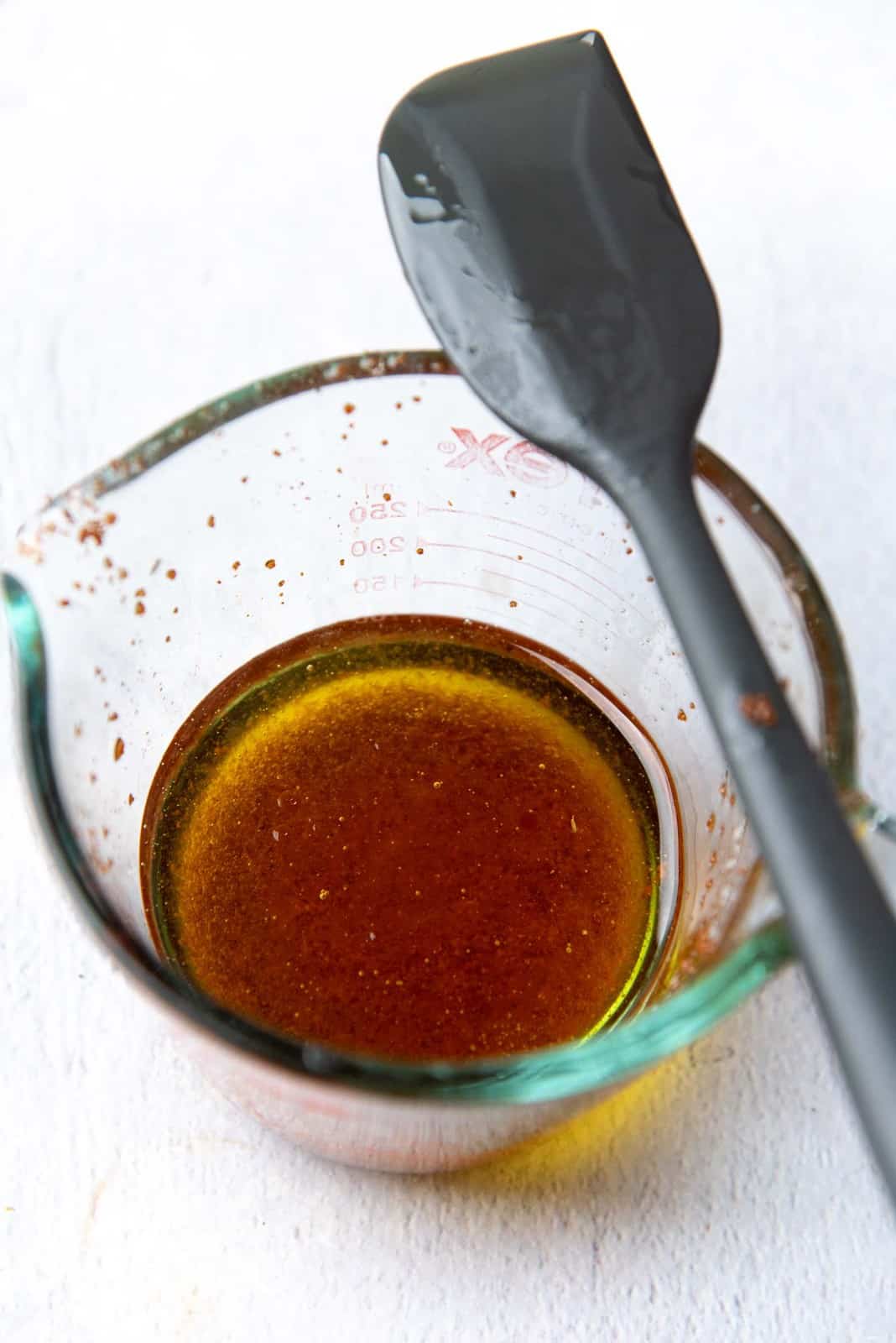
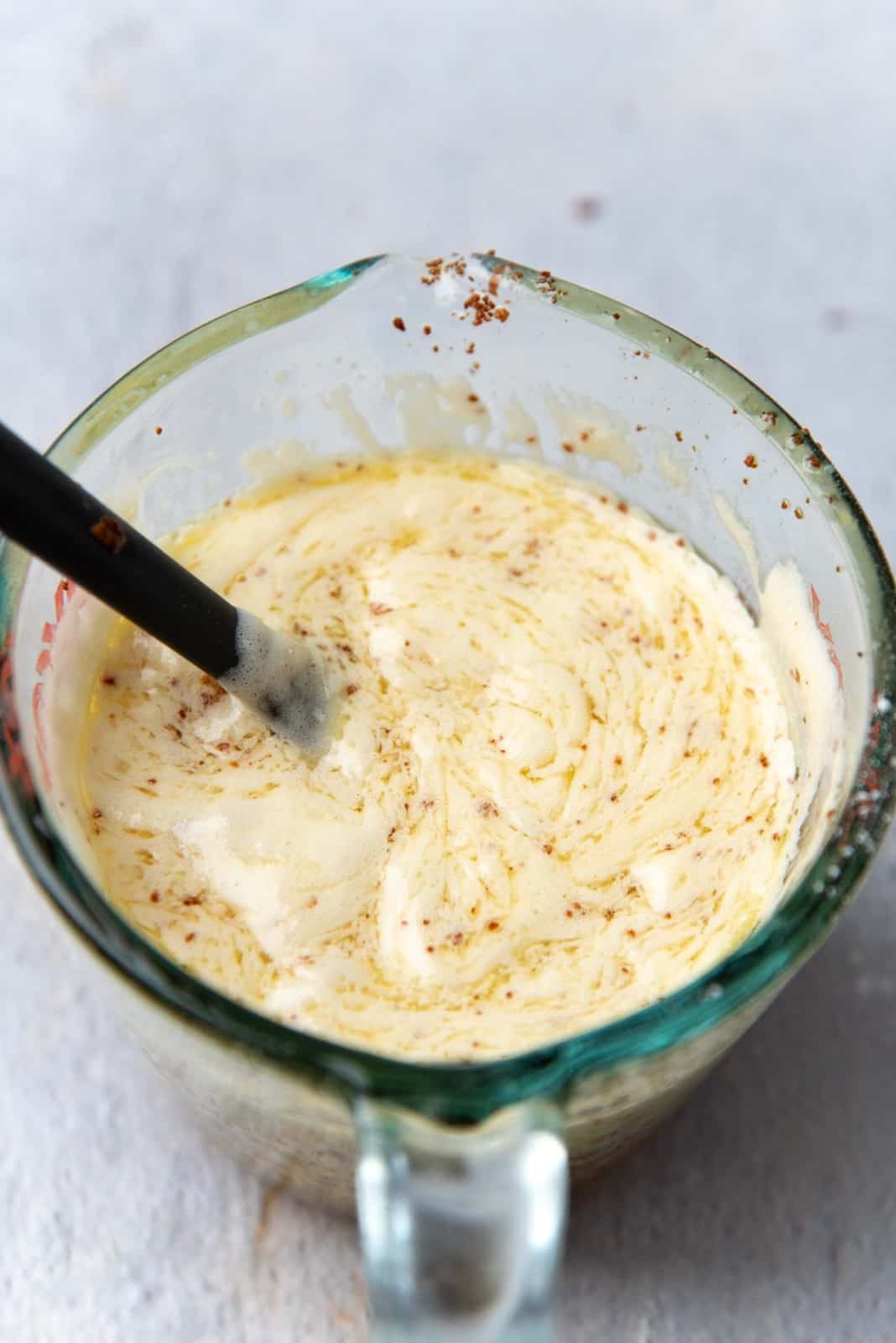
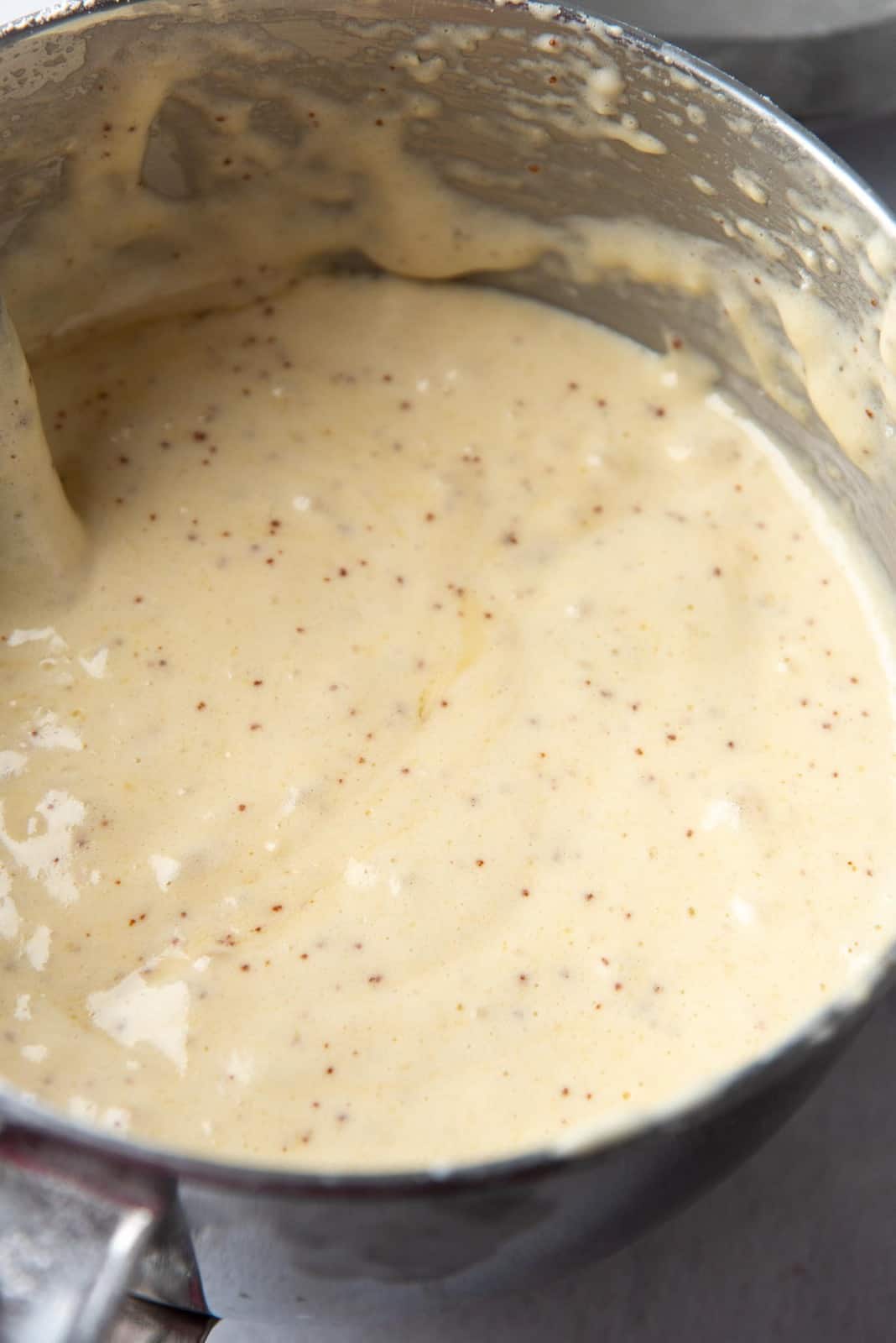
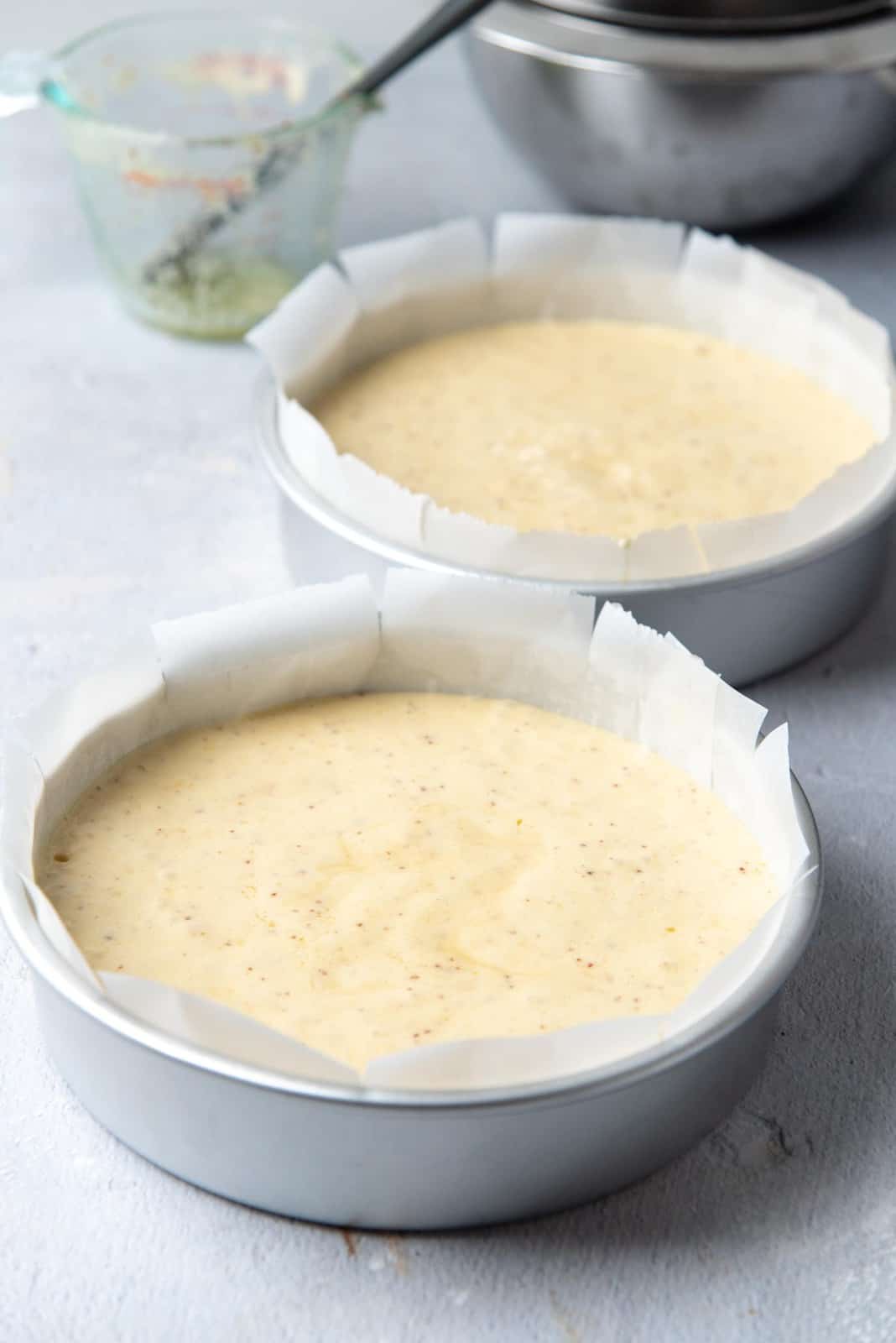
Sift the dry ingredients over the egg mixture and carefully fold them through. Mix about 3/4 cup of the batter with the melted warm butter / clarified butter / brown butter. Fold this mixture into the rest of the cake batter. Be very careful here, because vigorous mixing can deflate the batter.
Pour the cake batter into the prepared cake pans. Bake in the preheated oven until cooked through.
How to prep the cake layers
If you follow this recipe, you will end up with two 8 inch cake layers.
Carefully turn the slightly warm cake layers out onto a cooling wire rack, and let the cakes cool completely before brushing them with the mulled wine.
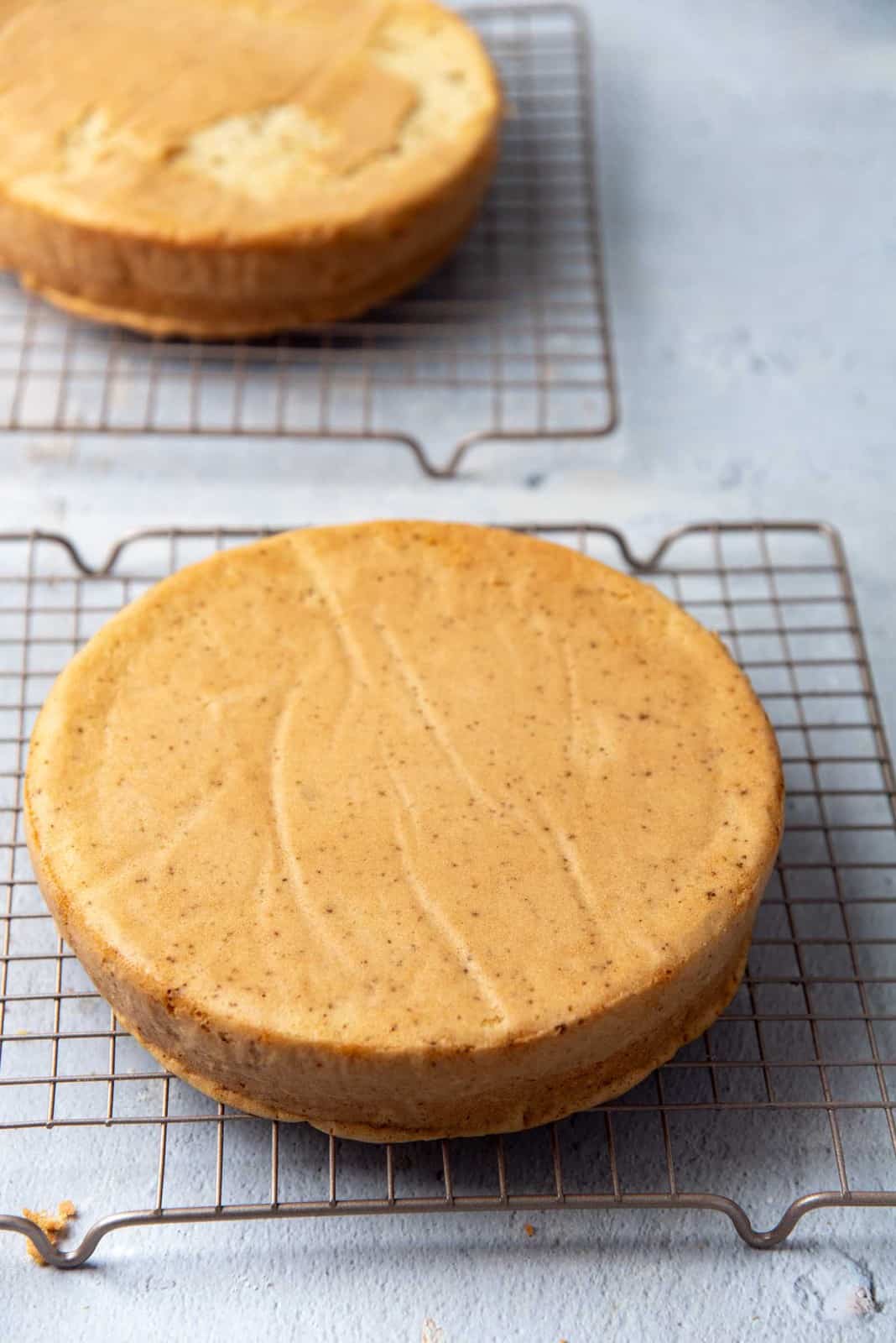
Once cooled, slice the tops of each of the cake layers to make them even. Warm the mulled wine and brush it all over the cakes. Let the syrup cool down and be absorbed by the cake layers.
Wrap each of the cake layers in plastic wrap and store until needed. I usually keep them in the fridge.
Mulled wine whipped cream frosting
Make the mulled wine whipped cream frosting when you’re ready to assemble the cake.
The mulled wine cake is frosted with this light frosting that is made with stabilized chantilly cream (sweetened whipped cream) that is also flavored with the mulled wine syrup!
Here I’m making the whipped cream frosting with whipped cream stabilized with gelatin. There are other options to “stabilize” whipped cream, but gelatin is the best option for frosting.
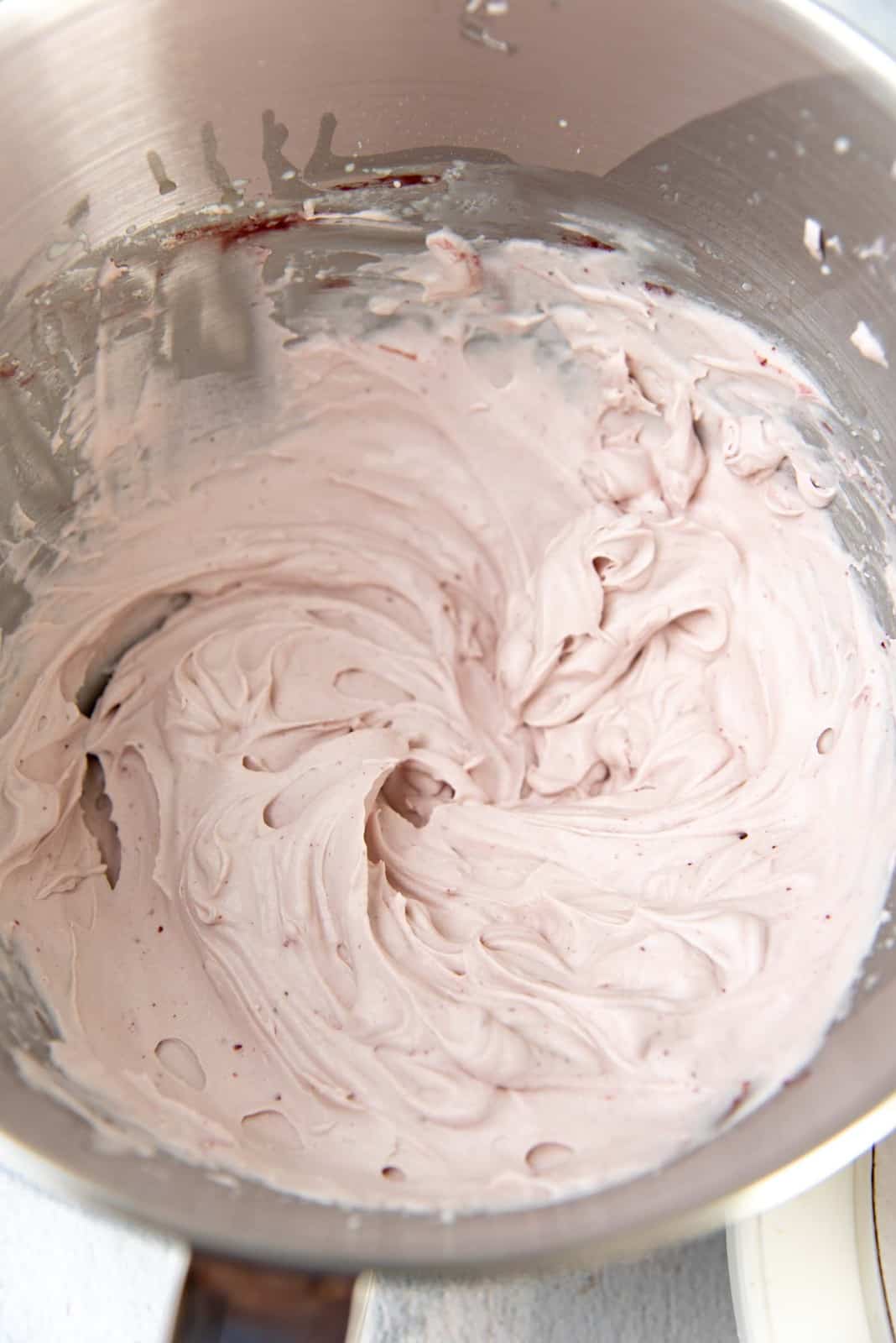
The formula that I like to use for stabilized whipped cream frosting is,
- 1 cup of cream (at least 35% fat)
- 3/4 tsp gelatin, bloomed in 2 1/4 – 2 1/2 tsp water
- 40 – 50 g of sugar
- 1 tsp vanilla extract
To cover the whole mulled wine cake, you will need at least 3 cups of heavy whipping cream to make the wine flavored whipped cream frosting.
The first step is to bloom the gelatin. I use powdered gelatin, because that is what is widely available. Once bloomed, melt the gelatin in the microwave for just a few seconds. Do not let the gelatin boil. Then temper the gelatin mix with about 1 – 2 tbsp of heavy cream. This is to avoid adding hot gelatin into the cold cream.
While the gelatin is blooming, place the CHILLED cream in a mixing bowl (that is preferably chilled as well). Add the sugar and vanilla.
Start whisking the cream until it starts to form some bubbles on the surface. Heat and temper the gelatin mix. Add the tempered gelatin mixture into the cream and IMMEDIATELY whisk the whipping cream on high speed. This needs to be done carefully because you want the gelatin mix to be dispersed in the cream as soon as it’s added, to prevent the gelatin from clumping and warming the heavy cream.
After the gelatin is mixed in (about 30 – 40 seconds on high), lower the speed to medium and whisk the cream. Add the chilled mulled wine syrup/concentrate and whisk to mix well. Whisk until you have semi-stiff peaks (between soft and stiff peaks).
Now the whipped cream is ready to be used immediately to frost and fill the mulled wine cake.
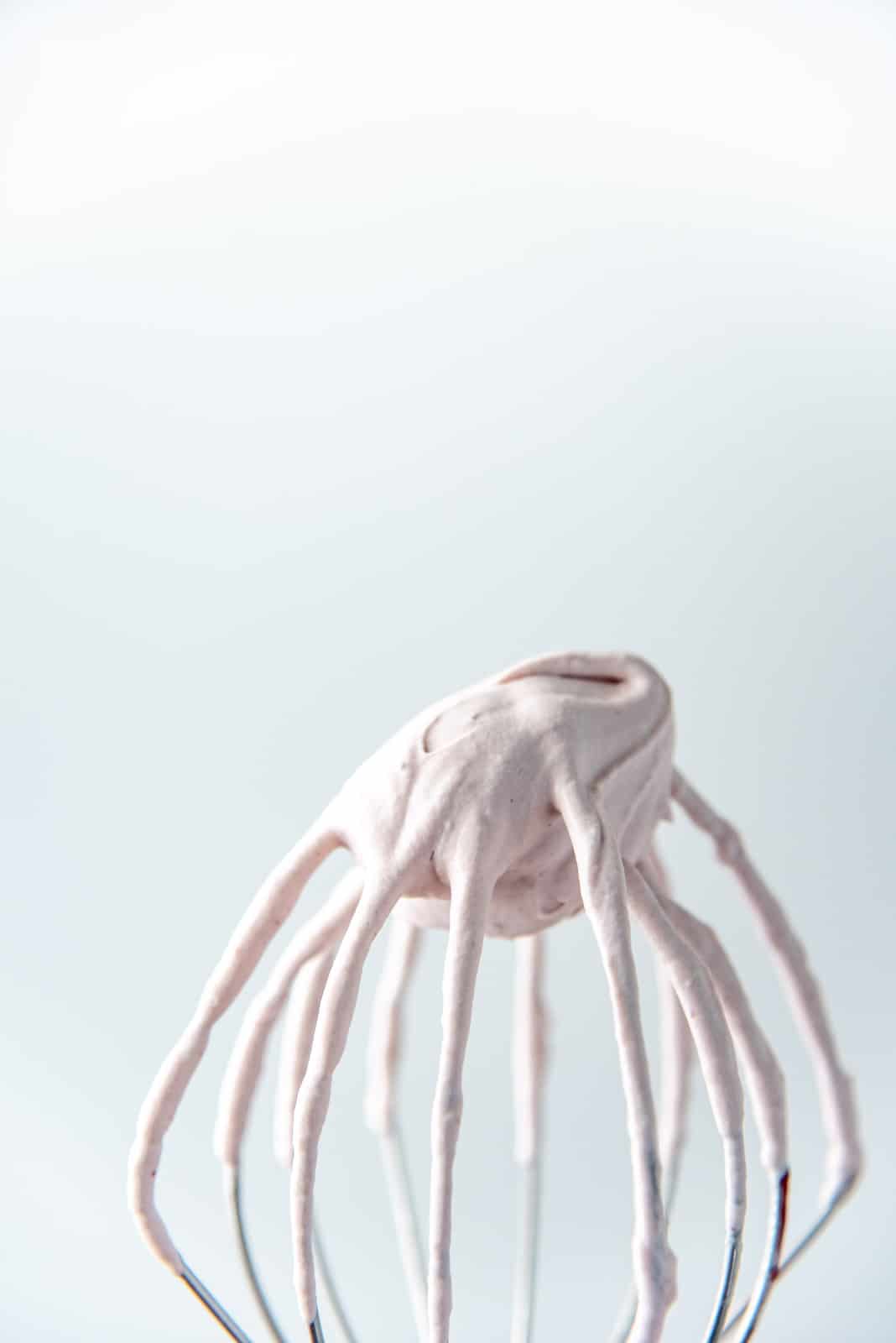
Assembling the mulled wine cake
To assemble the cake, make sure to have the fruits prepped BEFORE you start making the whipped cream frosting. Here, I use fresh raspberries and peaches, but you can use other fruits too. Here are some suggestions,
Fruit suggestions for the mulled wine cake filling
- Raspberries
- Blackberries
- Strawberries
- Orange or mandarin segments (without the membrane)
- Peaches (fresh or canned, but canned will be easier to cut through)
Place the mulled wine brushed cake layer on a flat plate (I use a rotating cake decorator). Spread a layer of the mulled wine flavored whipped cream on the top of the cake layer. It should be about 3/4 inch thick. Place some fruits all over the cream and gently press the fruits into the cream. Add a little more whipped cream on top to cover the fruits, and to make the frosting layer even.
Top it with the second cake layer, making sure the flat surface (cake bottom) is facing up. Use the mulled wine whipped cream to “crumb coat” the cake, by spreading a thin layer all over the mulled wine cake to make the sides and top level and straight.
Follow that with another layer of whipped cream frosting that is a little thicker, as the final layer of frosting. Decorate however you like.
Refrigerate the mulled wine cake, and add more fruits on top just before serving.
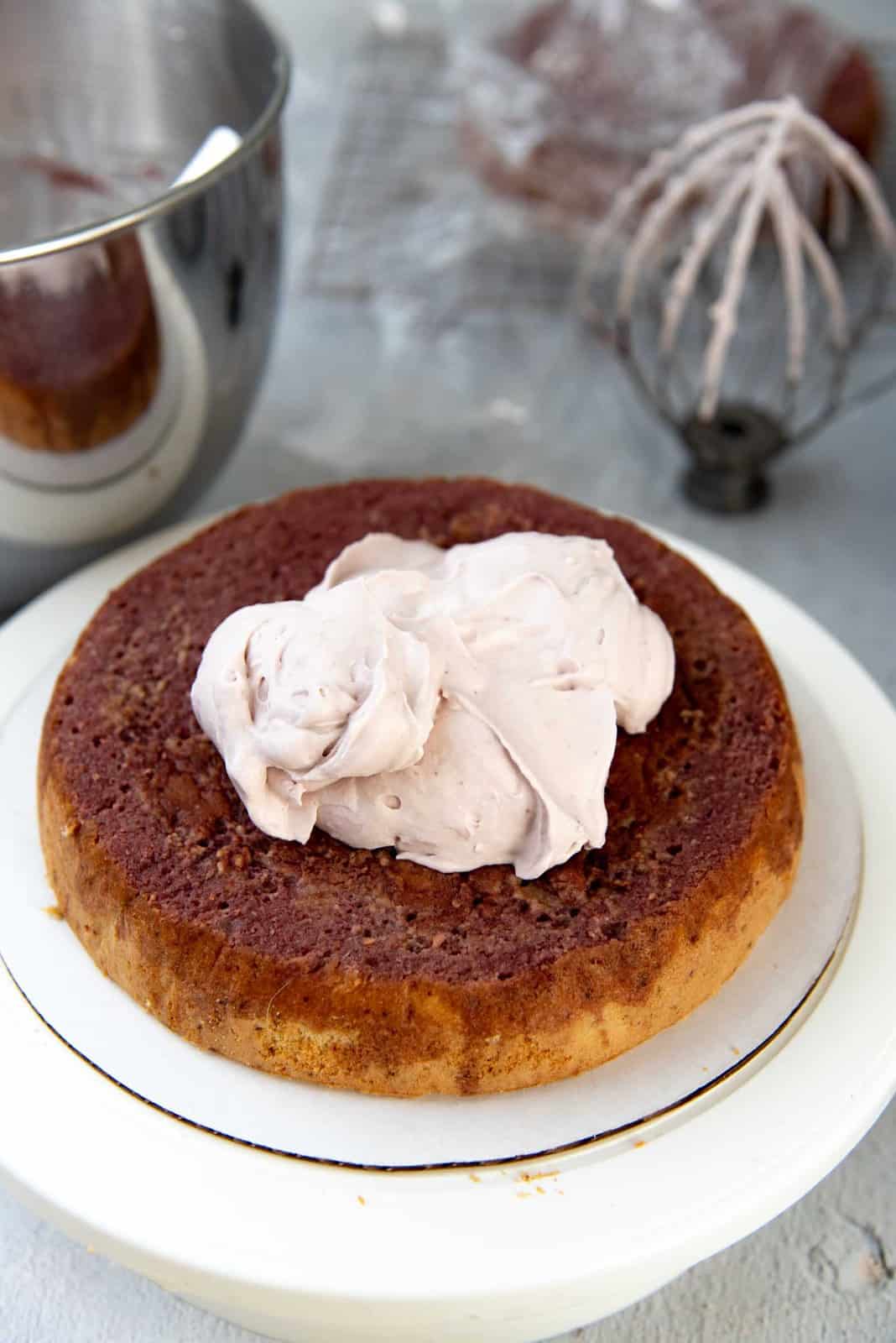
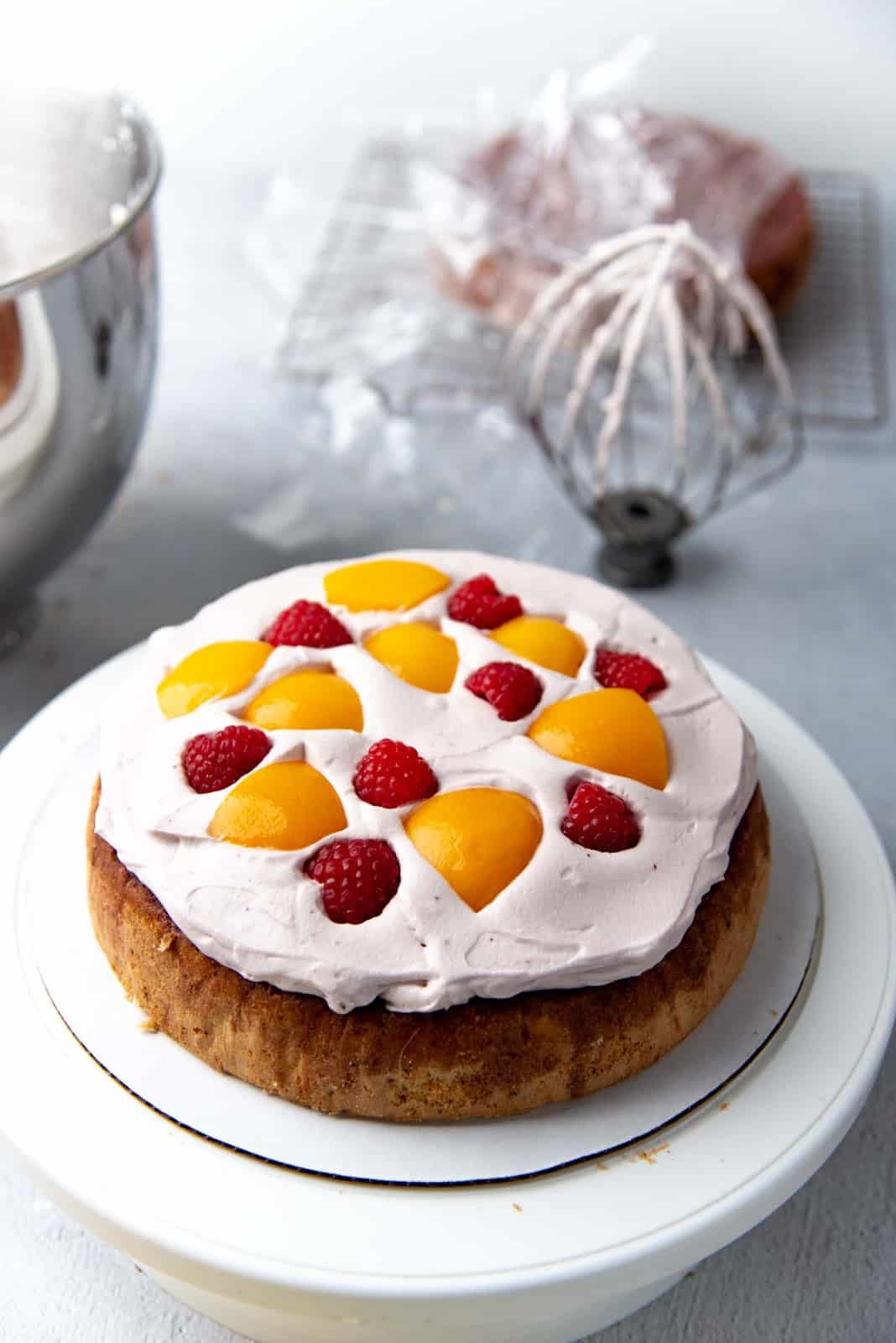
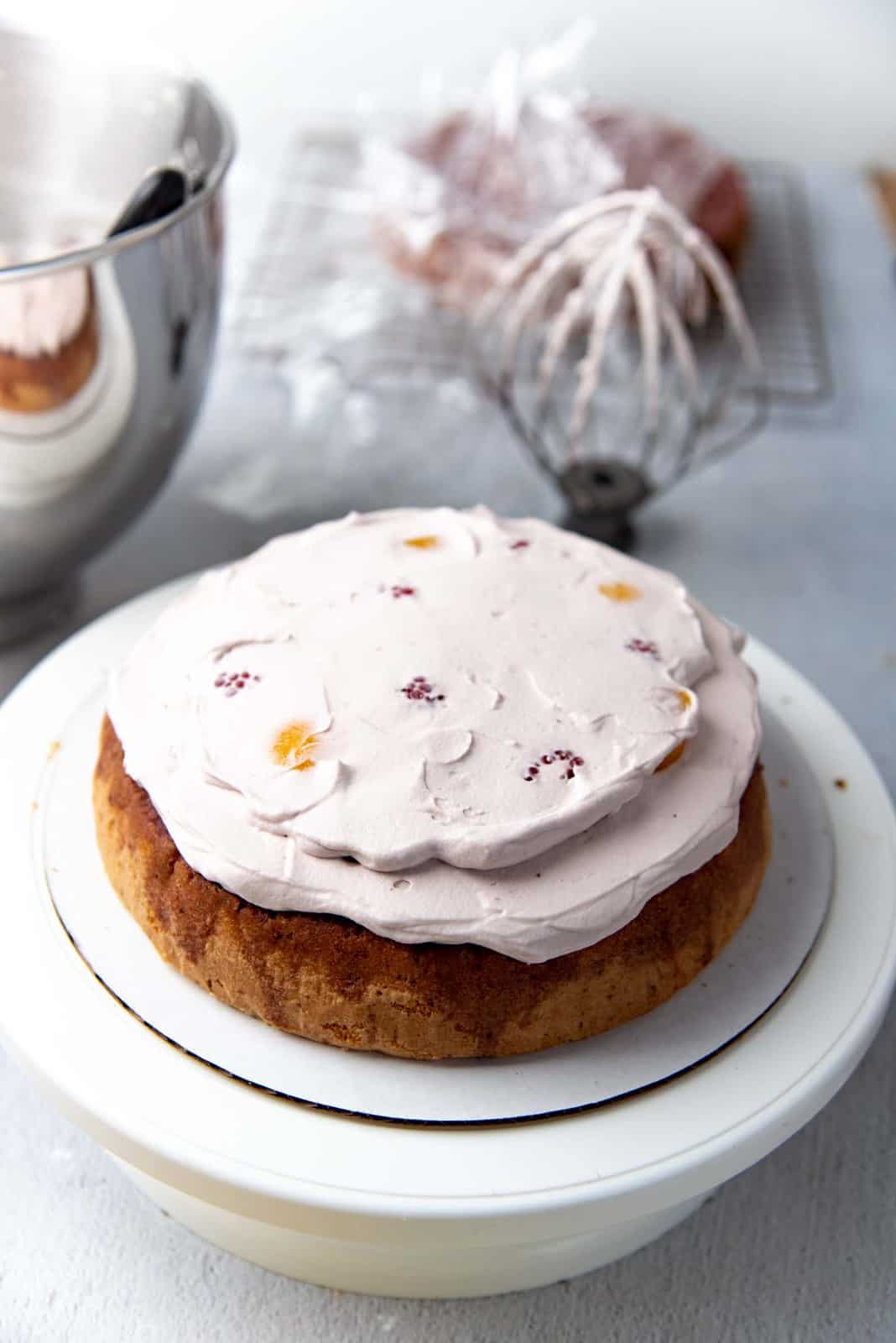
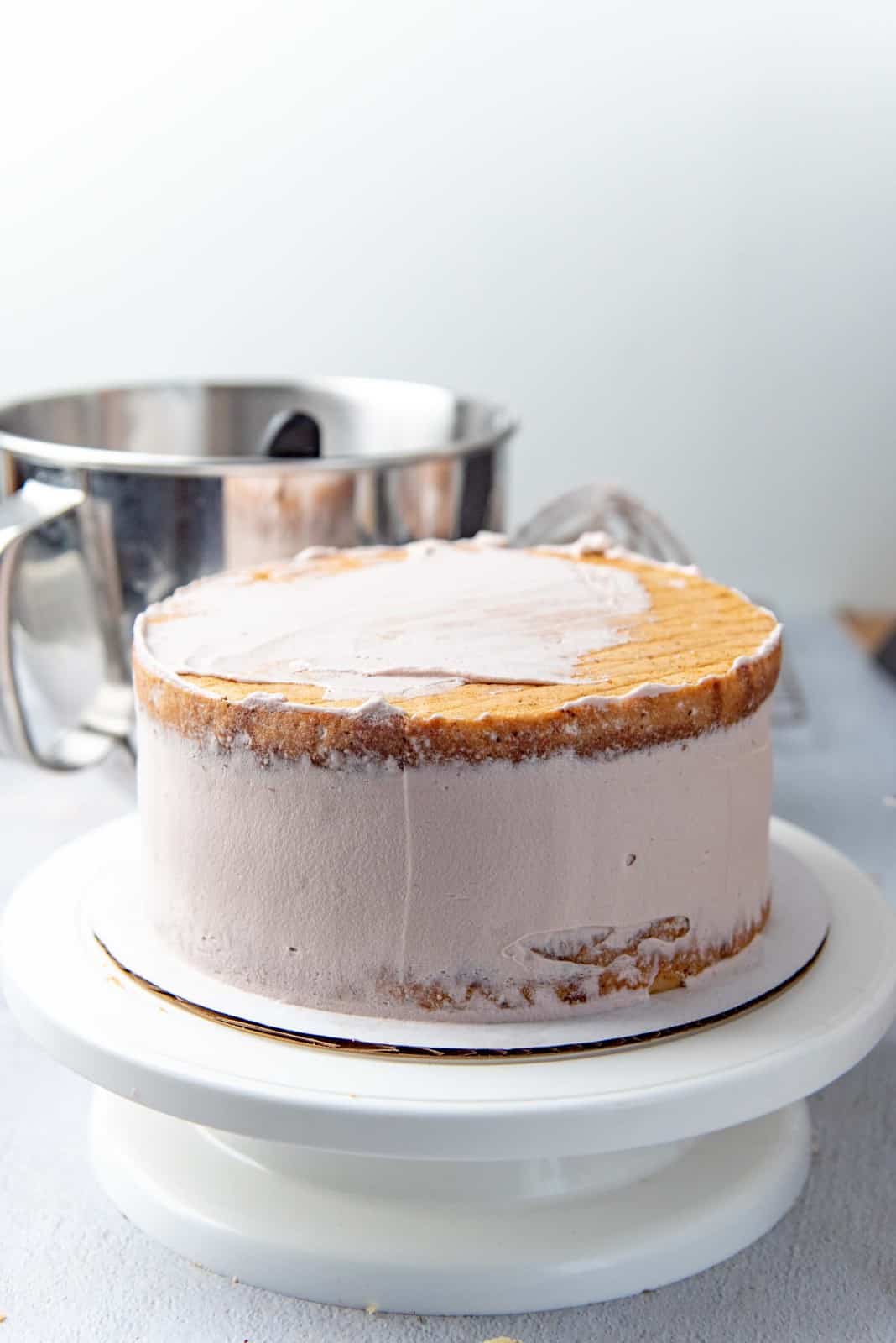
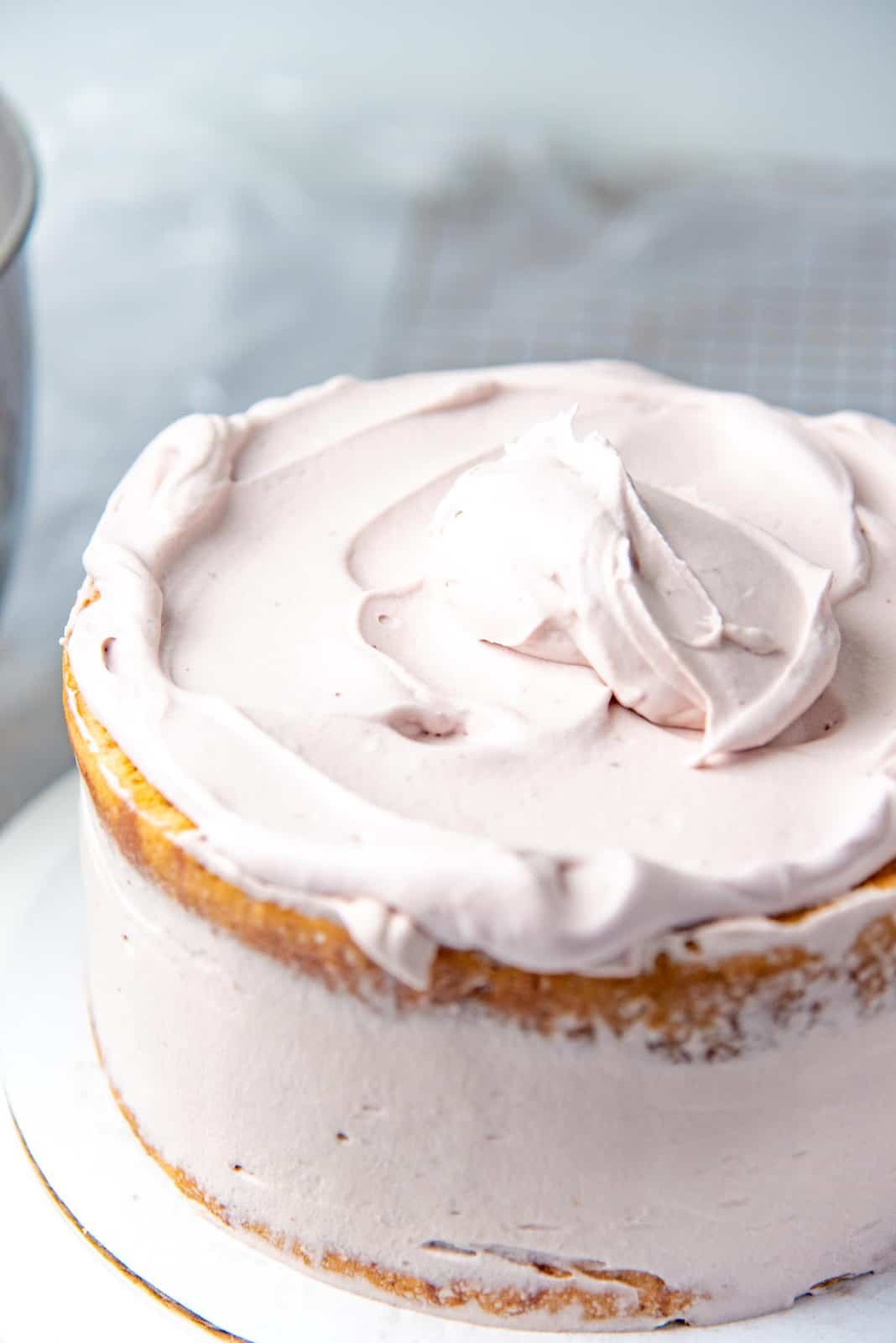

Tips on how to cut perfect slices
A sharp knife is very important for cutting any cake, but especially important with the sponge cake in this mulled wine cake.
You can use a sharp bread knife and cut the cake in a slight “sawing” motion. However, you will need to cut right through the cake, instead of cutting individual slices.
I prefer to use a sharp, straight edged knife. If the blade is warm, it’ll cut through the cake with a little more ease as well. Make sure to wipe the blade after each cut to get nice, clean cuts.
Tips for perfecting this recipe
Tips for the sponge cake
- The eggs can be chilled or at room temperature, because the eggs are going to be heated anyway. If the eggs are chilled, they may need to be heated for a couple more minutes.
- Whisk for at least 6 – 8 minutes. This will ensure that the egg foam is stable.
- Sift the dry ingredients twice. Once on their own, and the second time over the egg foam. Sifting will make it easier to fold the flour through the egg foam, and make it less likely to form clumps.
- Fold in the ingredients very gently. If the batter if deflated, the cake will be dense.
- The best way to incorporate fat into the cake batter is to mix the melted butter/fat with a small portion of the egg foam batter. This mixture is easier to fold through the batter because it won’t sink to the bottom.
- Make sure to line the cake pan with parchment paper to prevent the cake from sticking to the pan. If you use nonstick spray or butter, the cake may absorb the butter and deflate.
- The cake is easier to cut when it’s at room temperature or chilled. So make sure you only trim the cake once it has cooled down.
- The cake will only absorb the mulled wine when either the wine or the cake is hot. So make sure the mulled wine is warm / fairly hot when you brush the cake with it.
- Cakes that are chilled are easier to handle and less delicate. This is not mandatory, but an optional step that will make assembling the cake easier for you.
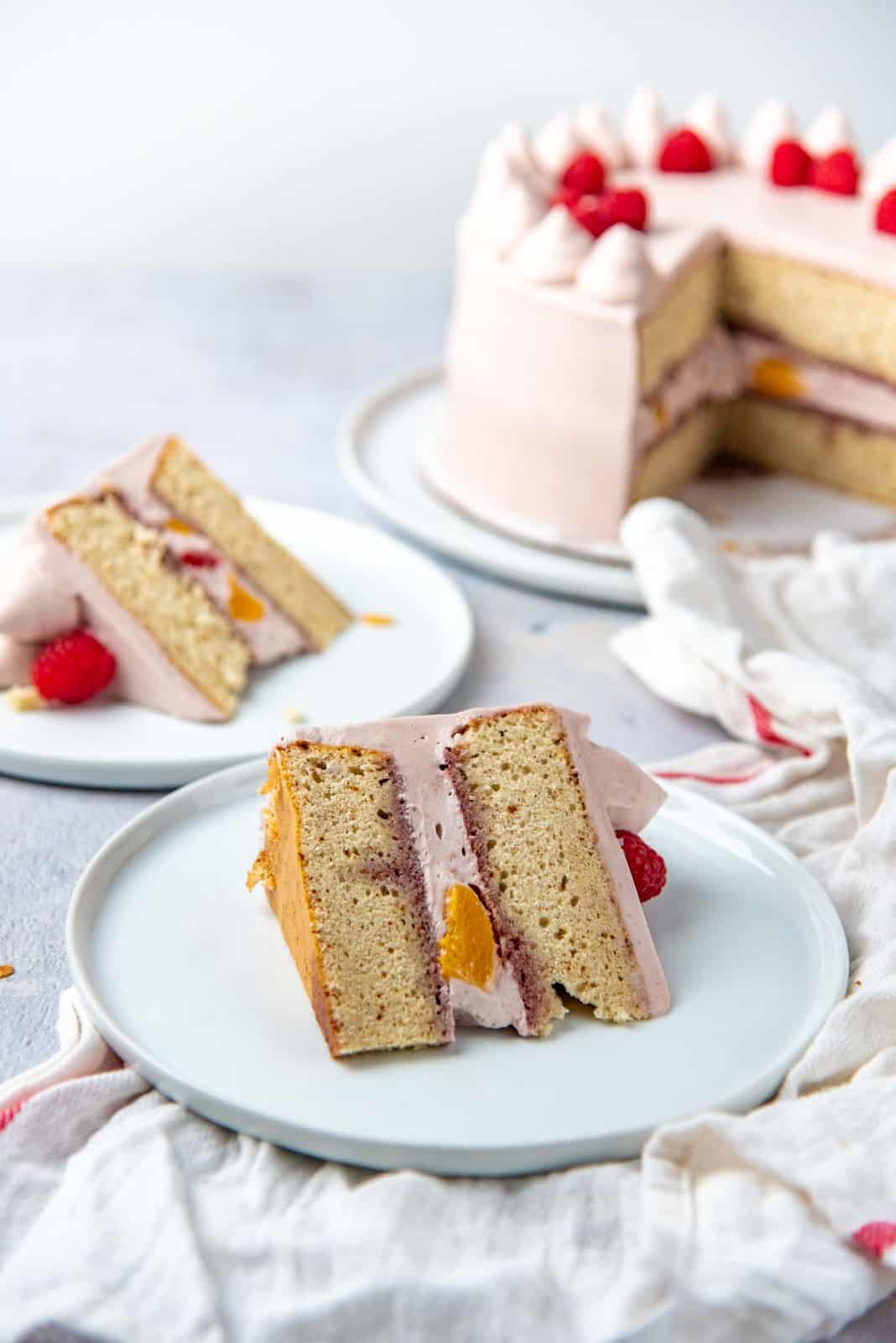
Tips for the whipped cream frosting
- When whipping the cream, it’s crucial that you do not over-whip. Over-whipping will lead to whipped cream that looks curdled, and it’ll be hard to achieve a smooth surface with it.
- The more the whipped cream is handled (when smoothing it out, piped with a piping tip etc.), the more it will be over-whipped and curdle.
- Chill the bowl, and whisk before whipping the chilled cream. Also make sure the mulled wine syrup is chilled too. This is to ensure that the cream whips properly.
- Once the gelatin is heated, temper the mix with cold cream. If you add hot gelatin into the cream, the cream mixture may not whip properly.
- Chill the frosted mulled wine cake so that the gelatin in the whipped cream sets, for at least 30 minutes. But you can bring the cake to room temperature before serving if you like.
What I love about this Mulled Wine Cake
This cake is ridiculously delicious. Fruity, light, just sweet enough, and fresh – it’s the perfect ending to any meal.
Sponge cakes are lighter than other cakes, so they make for an ideal light dessert. The addition of whipped cream frosting further maintains that refreshing lightness.
The mulled wine is great to enjoy on its own, but is the perfect fruity addition to this cake.
I’ve served this fruity, spiced, light and sweet cake at several gatherings so far, and it is ALWAYS, a huge crowd favorite! 🙂 Even those without a sweet-tooth and find regular cakes to be too sweet, cannot resist this mulled wine cake!
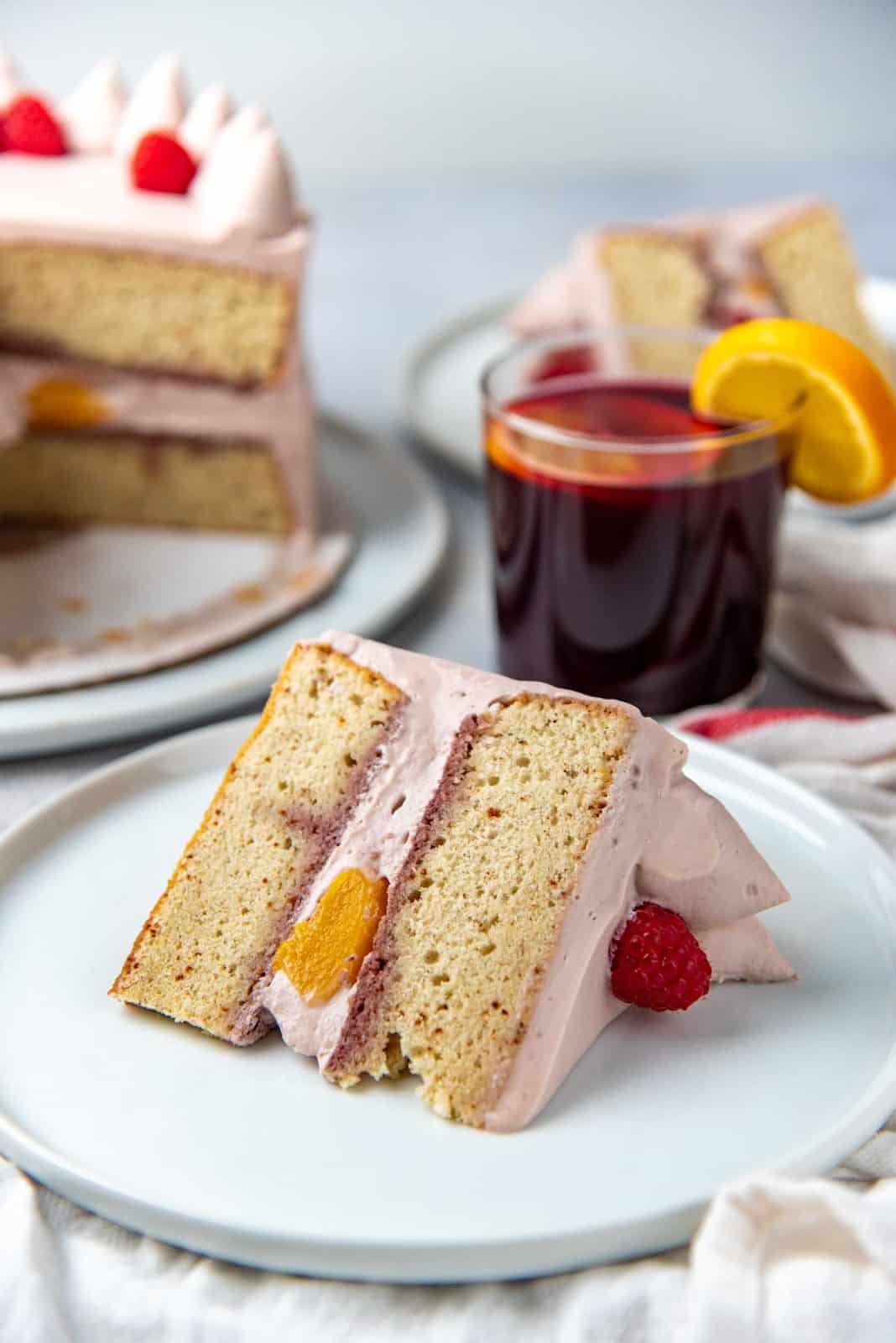
More cake recipes you’ll love
- Banana layer cake
- Easy carrot cake with cream cheese frosting
- Red velvet cake with cream cheese frosting
- Coffee layer cake (espresso cake)
- Ginger cardamom cake with rose buttercream (Magnolia cake)
- Classic white cake
- White coconut cake with lemon buttercream (Winter cake)
- Lemon raspberry cake
- Best vanilla cake
- Best chocolate cake
Looking for more recipes?Sign up for my free recipe newsletter to get new recipes in your inbox each week! Find me sharing more inspiration on Pinterest and Instagram.
Mulled Wine Cake with Whipped Cream Frosting
Ingredients:
Sponge cake
- 86 g butter 6 tbsp
- 2 tsp vanilla extract
- 200 g cake flour about 1 ⅔ cup
- ½ tsp baking powder
- 8 large eggs about 410 – 450 g
- 200 g white sugar 1 cup
Mulled wine
- 750 ml red wine
- 1 orange sliced
- 8 cloves use less if the cloves are big
- 1 star anise
- 1 cinnamon stick 3 – 4 inch stick
- 100 g white sugar ½ cup
Mulled wine whipped cream frosting
- 3 cups chilled whipping cream at least 35% fat
- 2 ¼ tsp powdered gelatin
- 3 ¾ tbsp water
- 2 tbsp chilled whipping cream
- 1 tbsp vanilla extract
- 2 tbsp confectioner's sugar optional
- 5 – 6 tbsp mulled wine syrup recipe above
To serve (for filling and topping the cake)
- ½ cup fresh raspberries
- ½ cup drained, diced canned peaches
Instructions:
Sponge cake
- This cake can be made one day before assembly.
- Preheat the oven to 350°F / 180°C.
- Line two 8 inch cake pans with parchment paper. Use just a little butter to stick the parchment paper to the cake pan. Set aside.
- Melt the butter in a small saucepan over medium heat. Optional – for added flavor, heat the butter (while stirring) to make brown butter.86 g butter
- Stir in the vanilla when the butter has cooled down slightly. Then set the mixture aside, but make sure it's slightly warm when it's mixed into the cake batter.2 tsp vanilla extract
- Sift the flour and baking powder together in a separate bowl, and set aside until needed.200 g cake flour, ½ tsp baking powder
- In a medium saucepan (that can be used as a double boiler for your mixing bowl), bring about 2 inches of water to a simmer over medium or medium high heat.
- In your mixing bowl or a metal bowl, place the eggs and white sugar, and whisk to mix gently.8 large eggs, 200 g white sugar
- Place the mixing bowl over the simmering water and whisk the egg mixture while heating. Make sure to whisk the eggs continuously for about 3 – 5 minutes until the egg mixture reaches a temperature of about 110 – 120°F.
- Remove the egg mixture from the heat. And remove the saucepan from the heat.
- Place the mixing bowl in your stand mixer with the whisk attachment. Whisk on high speed for about 5 – 6 minutes. The eggs should at least triple in size.
- To check if the egg mixture is at the right consistency, take some of the egg mixture with your whisk attachment and create some ribbons on the surface. The ribbons should remain on the surface and not immediately disappear.
- Sift the dry ingredients evenly over the surface of the egg mixture. Make sure it’s sifted evenly, so that the flour doesn’t collect at one spot and sink to the bottom.½ tsp baking powder, 200 g cake flour
- Using a wide spatula (or the largest spatula you own), fold the flour into the egg mixture. Rotate the bowl after every fold to make sure all the flour is well incorporated, and there are no dry spots in the batter or the bottom of the bowl. Be careful not to deflate the mixture by overmixing.
- To mix the vanilla butter mixture – As mentioned above, this mixture should be slightly warm before being mixed in. If not, microwave for a few seconds to warm it up.86 g butter, 2 tsp vanilla extract
- Add roughly 1 cup of the cake batter (using your spatula) to the butter vanilla mix. You do not need to measure this accurately, just eyeball the amount. Mix well to incorporate the butter and cake batter until emulsified.
- Gently pour the butter-batter mix evenly over the surface of the rest of the cake batter in the mixing bowl. I use the flat side of my spatula to break the flow of the butter-batter mixture as I do this, so that it doesn’t sink to the bottom of the bowl.
- Fold the mixture into the rest of the cake batter. Do this gently with as few folds as possible, so as not to deflate the cake batter.
- Pour the batter into the prepared cake pans (about 400 – 420 g per cake pan). Knock the pan on a hard surface about 3 – 4 times to remove excess air in the batter.
- Bake in the preheated oven for about 20 – 30 minutes or until the cake is baked through. A toothpick inserted into the cake should come out clean when the cake is done.
- Remove the cake from the oven and let the pans cool slightly.
- Carefully turn the cakes out from the pan, onto a wire rack and let them cool completely.
- Once cooled, trim off the tops of the cakes to make them level.
- Brush the tops of the cakes with the reserved hot mulled wine (recipe below). Let it soak for about 15 minutes.
- Wrap the cakes well (individually), and refrigerate for up to 24 hours.
Mulled wine and mulled wine syrup
- This can be made the day before assembly as well.
- Place all the ingredients for the mulled wine in a saucepan. Heat the wine until it starts to simmer. Stir frequently to prevent the wine from burning.750 ml red wine, 1 orange, 8 cloves, 1 star anise, 1 cinnamon stick, 100 g white sugar
- Turn off the heat and cover the saucepan and let the wine sit for about 20 – 30 minutes to let the spices infuse.
- Once the wine is infused, strain the wine to remove all the spices, and gently squeeze the orange slices to add the juice to the wine as well.
- Reserve ¾ – 1 cup of the mulled wine and set it aside. This will be brushed on top of the cake layers. Heat this mix before using it to brush the tops of the cakes.
- Mulled wine syrup – Return the rest of the wine back to the saucepan and heat until it comes to a boil.
- Lower the heat to a simmer and let the wine simmer until it’s reduced to about ¾ cup. Transfer the mulled wine syrup into a bowl and set it aside. It should have a thick, syrupy consistency when cooled. Chill until needed.
Mulled wine whipped cream frosting
- Make this frosting once the cake layers are soaked with mulled wine, and you’re ready to assemble the cake.
- Make sure the mixing bowl, whisk, and cream are chilled in the fridge.
- Pour the 3 cups of heavy cream into the chilled mixing bowl, and keep it in the fridge until you're ready to whip.3 cups chilled whipping cream
- In a small microwave-safe bowl, place the water and sprinkle the gelatin over the water. Stir gently to saturate the gelatin with the water. Set it aside for at least 10 minutes to let the gelatin bloom.2 ¼ tsp powdered gelatin, 3 ¾ tbsp water
- Place the chilled mixing bowl with the cream in your stand mixer with the whisk attachment.
- Start whisking the whipping cream on medium speed until it starts to form bubbles (just 1 – 2 minutes).
- While the cream is being whisked, microwave the bloomed gelatin for 10 – 20 seconds only until the gelatin is dissolved. DO NOT let the gelatin boil.
- Once the gelatin is melted, slowly add 2 tbsp of the chilled cream into the gelatin, while stirring. This is to temper the gelatin.2 tbsp chilled whipping cream
- Stop whisking, and add the tempered gelatin to the whipping cream very quickly, and immediately start whisking at high speed for 1 minute to make sure the gelatin mixes in thoroughly.
- When the cream is starting to thicken, add the vanilla, confectioner’s sugar and the mulled wine syrup. Let everything mix on medium speed. Scrape the sides and bottom of the bowl to ensure the wine syrup mixes evenly.1 tbsp vanilla extract, 5 – 6 tbsp mulled wine syrup, 2 tbsp confectioner's sugar
- The whipped cream should have mid peaks (i.e. not too soft, but not stiff peaks either). When held up on the whisk, the peaks should bend, instead of standing straight up.
- The whipped cream frosting is now ready and should be used immediately.
Assembling the mulled wine cake
- Unwrap the cake layers. Place one layer on a plate or a decorating stand.
- Spread a layer of the mulled wine whipped cream on top (about ¾ inch thick). Stud the layer with fresh fruit pieces (raspberry and peaches). Then place another thin layer of frosting on top of the fruits to level the frosting layer.½ cup fresh raspberries, ½ cup drained, diced canned peaches
- Place the second cake layer on top of this, making sure the flat bottom of this second cake layer is facing up.
- Add enough whipped cream frosting on the sides of the cake to get straight edges, and a thin layer on top to catch all the crumbs (this is the crumb coating).
- Follow this with another layer of the whipped cream frosting as the final frosting layer. You can make this smooth by using a bench scraper, or create swirls for a rustic look if you prefer.
- Decorate the cake with a simple piped border if you like.
- Refrigerate the cake to let the frosting set.
- When you're ready to serve it, top the cake with more fruits.½ cup fresh raspberries, ½ cup drained, diced canned peaches
Tips & Tricks
Tips for making this cake
- Sift the dry ingredients twice.
- Fold in the ingredients very gently.
- The cake will only absorb the mulled wine when either the wine or the cake is hot.
- Cakes that are chilled are easier to handle and less delicate.
- Chill the bowl, and whisk before whipping the chilled cream.
- Temper the gelatin mix with cold cream before adding it to the whipped cream.
- Chill the frosted mulled wine cake so that the gelatin in the whipped cream sets
Nutrition Information:
“This website provides approximate nutrition information for convenience and as a courtesy only. Nutrition data is gathered primarily from the USDA Food Composition Database, whenever available, or otherwise other online calculators.”

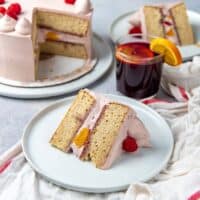
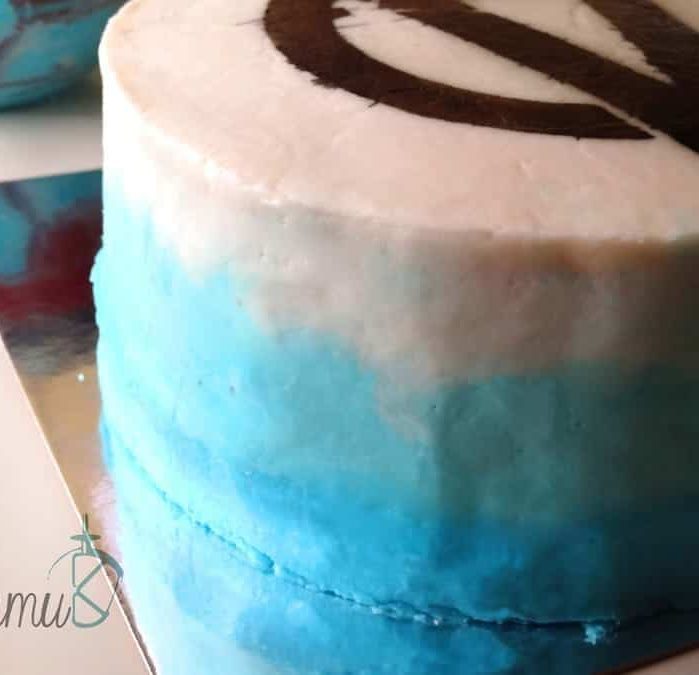
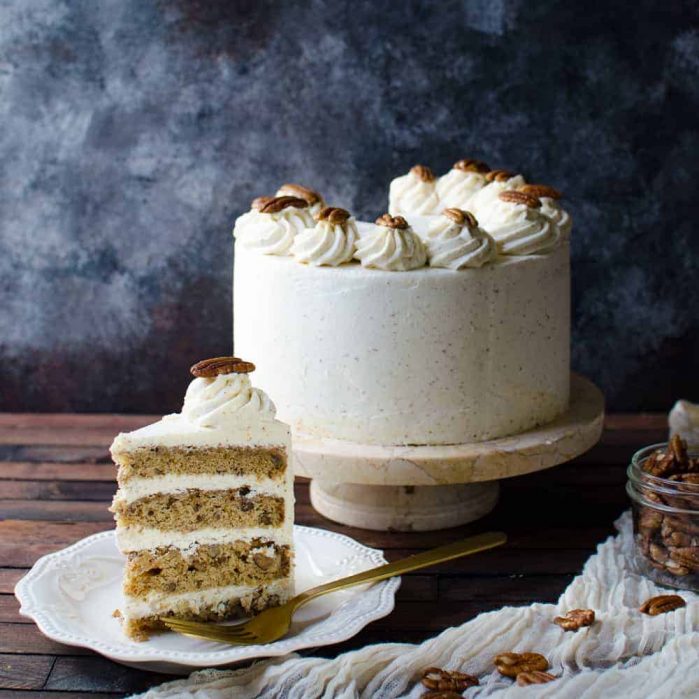
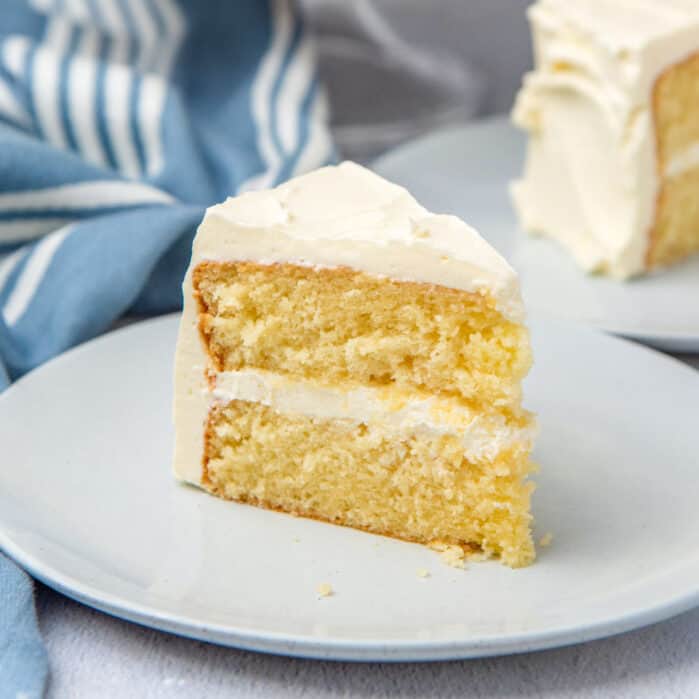
Marina says
Excellent recipe! I followed it exactly and it turned out perfect. The only modification I made was to add more powdered sugar and vanilla to the whipping cream. Also next time I will double the amount of spices to the wine!
shl says
This sounds perfect for my dad’s birthday coming up! My oven is too small to bake two cake pans simultaneously, though. Would you recommend I make up the batter as written and leave half in the fridge while I bake one cake-half, or divide the recipe and make each cake-half fresh? Or use a bigger pan and split the cake?
Dini says
Hi Shl
With usual cake batters, like my vanilla cake – I’m not too fussed about splitting the batter and baking one after the other. This is because the cake relies on baking powder for the rise. However, with this cake the air in the batter is what acts as a raising agent. The longer the batter sits out the more it can deflate and create a denser cake.
You could bake the cake in a pan with higher edges at least 4 inches, at a lower oven temperature for longer – but I haven’t done this myself so I can’t be sure what the temperature / time should be.
I would recommend either making half the batter first for one layer and then making the second half of the batter while the first bakes. OR switching the cake to a vanilla cake recipe.
I hope that helps!
shl says
Yes, that’s very helpful! Thank you!